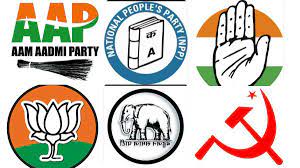Political parties play a crucial role in the democratic process of India. India is a multi-party system, which means that multiple political parties compete for power and representation in the government. In this article, we will discuss an overview of political parties in India, their history, structure, and significance in the Indian political landscape.

Table of Contents
History of Political Parties in India
Political parties in India emerged during the freedom struggle against the British colonial rule in the early 20th century. The Indian National Congress, founded in 1885, was the first political party in India. The Communist Party of India was formed in 1925, and other parties such as the Bharatiya Janata Party (BJP), Communist Party of India (Marxist), and Bahujan Samaj Party were formed in the decades that followed.
Structure
Political parties in India are structured hierarchically, with a national leader at the top, followed by state-level leaders and local leaders. The national leader is usually the president of the party, who is elected by members of the party. The state-level leaders are responsible for managing the party’s affairs in their respective states, while the local leaders are responsible for managing the party’s affairs in their respective constituencies.
Significance
They play a critical role in shaping the country’s political landscape. They are responsible for contesting elections, forming governments, and representing the people in the Parliament and State Assemblies. Political parties also play a critical role in policy-making, as they often present their own agendas and programs to the public. Additionally, political parties act as a check on the government’s power and hold them accountable for their actions.
Political Parties in India
Political parties in India can be classified in various ways based on their ideology, political affiliation, representation, and participation in elections.
- National Parties: These are political parties that have a nationwide presence and have won seats in multiple states in the country. Currently, there are seven recognized national parties in India, including the Indian National Congress (INC), Bharatiya Janata Party (BJP), Communist Party of India (Marxist) (CPI-M), Communist Party of India (CPI), Nationalist Congress Party (NCP), Bahujan Samaj Party (BSP), and All India Trinamool Congress (AITC).
- Regional Parties: These are political parties that have a strong presence in a specific state or region and usually represent the interests of that particular region. Examples of regional parties include the Dravida Munnetra Kazhagam (DMK) in Tamil Nadu, the Telugu Desam Party (TDP) in Andhra Pradesh, and the Shiv Sena in Maharashtra.
- Left Parties: These are political parties that have a socialist or communist ideology and are left-leaning in their political outlook. Examples of left parties in India include the Communist Party of India (CPI) and the Communist Party of India (Marxist) (CPI-M).
- Right-wing Parties: These are political parties that have a conservative or nationalist ideology and are right-leaning in their political outlook. Examples of right-wing parties in India include the Bharatiya Janata Party (BJP) and the Shiv Sena.
- Centrist Parties: These are political parties that are neither left-leaning nor right-leaning and usually take a moderate stance on political issues. Examples of centrist parties in India include the Indian National Congress (INC) and the Nationalist Congress Party (NCP).
- Single-Issue Parties: These are political parties that focus on a specific issue or cause, such as the Aam Aadmi Party (AAP) in Delhi, which focuses on anti-corruption and good governance.
- Unrecognized Parties: These are political parties that are not officially recognized by the Election Commission of India and have not met the required criteria to be considered as a national or state party. These parties usually have a limited presence and do not have significant electoral success.
Conclusion
In conclusion, political parties in India are an essential part of the country’s democratic process. They provide a platform for citizens to participate in the political process and hold their elected representatives accountable. While political parties in India have had their fair share of controversies and challenges, they continue to play a significant role in shaping the country’s political landscape.
Important Links